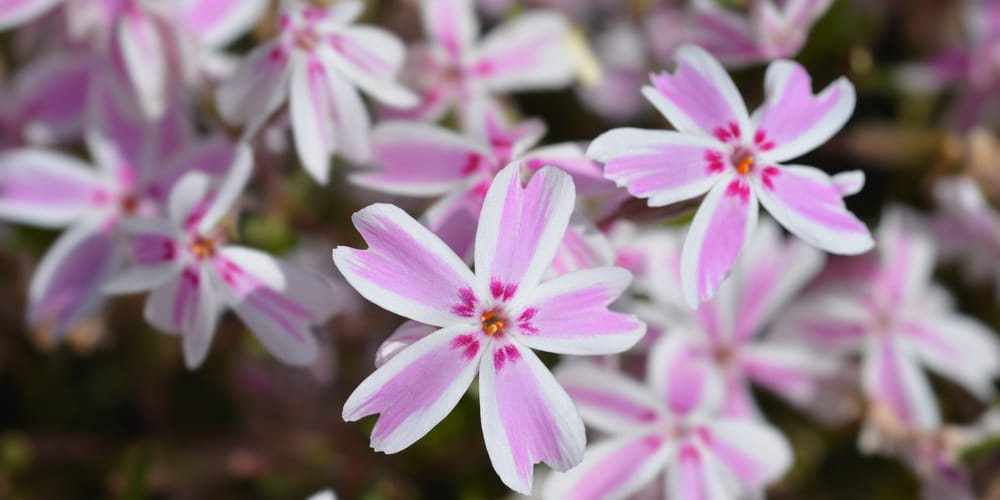If you’re looking for a plant that will add color and interest to your landscape, consider propagating creeping phlox. Here’s everything you need to know about how to propagate creeping phlox.
What is Creeping Phlox?
Creeping phlox (Phlox subulata) is a beautiful herbaceous perennial ground cover that is native to the eastern region of the United States. This evergreen plant has long, thin leaves and produces masses of colorful flowers in early spring.
It’s mostly low-growing and considered easy to grow. As a versatile plant, the creeping phlox can be used in a variety of landscape settings, including rock gardens, borders, and slopes.
There are several different cultivars of creeping phlox available, with flowers that come in a range of colors including white, pink, purple, and blue.
Propagating Creeping Phlox
If you’re trying to propagate creeping phlox, you can use either cuttings or divisions. And considering that this plant will do well in hardiness zones 3 to 9, you really are not limited when it comes to propagation locations.
In most cases, it’s best to let your young plants establish themselves in a greenhouse environment. That way, they can be protected from harsh weather conditions, like too much sun or wind. After your plants become hardy enough, you can then transplant them to their permanent outdoor location.
The good thing about creeping phlox plants is that they will generally be good when it comes to being drought and animal tolerant.
Here are more specifics on how to propagate creeping phlox using both cuttings and divisions.
1. Cuttings
You can use either stem or root cuttings to propagate your creeping phlox. The best time to take root cuttings from a creeping phlox plant is during middle fall through winter. For stem cuttings, the ideal time is late summer to early fall.
Make sure to choose a healthy plant that has not flowered yet and aim for a section of approximately four inches in length below a leaf. It’s especially crucial to confirm that neither the cutting nor the plant has symptoms of diseases or defects.
Preparation and rooting
After taking your stem cuttings, you then want to prepare them for rooting. First, cut off the leaves on the bottom half of the cutting using sharp shears. You can leave at least one leaf on the upper side of your stem cutting.
Next, dip the cuttings in rooting hormone powder, after which your should plant them in a moist and well-drained propagation mix. You can use a variety of materials for your propagation mix, including perlite, sand, and peat.
Make sure that the leaves are not touching the surface of the propagation mix and that the cutting is buried at least two inches deep. After planting, water your cuttings well. You can cover the pot or container with plastic to help retain moisture.
It’s recommended that you place your container in a location that offers indirect sunlight and maintain a consistent temperature while protecting the plant from any extreme conditions.
2. Divisions
You can also propagate your creeping phlox using divisions. This method is especially handy whenever you want to propagate during maintenance. What happens is that your creeping phlox plants will basically spread quite a distance that you feel the need to divide them.
This is generally done in spring after your plants have already bloomed.
Severing the roots
Thanks to the not-so-deep roots of the phlox plant, it’s easy to get this process done. It’s as simple as digging out the soil, lifting up and spreading the plant, and then cutting through the roots. There are even some indefinite that should guide you to some extent as you cut through. As you handle the roots, be sure to do so gently to avoid bending them to a point where they break.
Replanting the divisions
After you’ve cut through the creeping phlox plant, replant each division in its own hole. You may have to create more planting sections depending on the size of the individual divisions.
Again, make sure that the roots are not too deep in the soil and that there’s enough space for the plants to grow. You should preferably loosen the soil to encourage root growth as well.
Water your plants generously, after which you should maintain moisture until the plants have established. and then wait for a few weeks to see new growth.
Caring for Creeping Phlox
Once established, creeping phlox is a relatively low-maintenance plant. Water regularly during the first growing season to help the plants establish a deep root system. Once established, creeping phlox is quite drought-tolerant.
Fertilize creeping phlox in early spring with a balanced granular fertilizer. Apply the fertilizer according to the manufacturer’s directions, and scratch it into the soil surface.
Creeping phlox can be aggressive and may spread beyond its intended area. To prevent this, shear plants back after blooming to encourage dense, compact growth.
How to Propagate Creeping Phlox: In closing
Creeping phlox is a beautiful ground cover that is easy to grow and maintain. This versatile plant can add color and interest to any landscape.
Propagating creeping phlox from either cuttings or divisions is a pretty simple and rewarding project that anyone can do. With just a little care, your new plants will thrive and provide years of enjoyment.
Related Article: Why is My Phlox Not Flowering?


